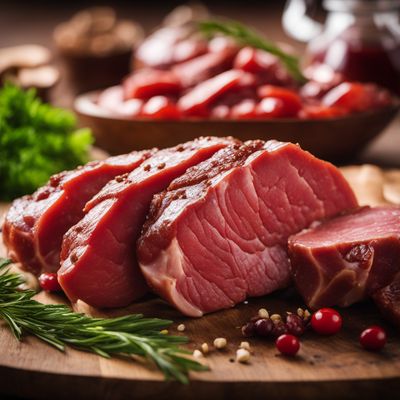
Ingredient
European moose meat
The Majestic Delicacy: European Moose Meat Unveiled
European moose meat is characterized by its deep red color, lean texture, and rich marbling. It has a distinct earthy and gamey flavor, with hints of sweetness. The meat is tender and succulent, making it ideal for various cooking methods such as roasting, grilling, or braising. Its versatility allows it to be used in a wide range of dishes, from hearty stews to gourmet steaks.
Origins and history
European moose meat has a long history in European cuisine, particularly in countries like Sweden, Finland, and Norway. It has been a traditional food source for indigenous communities and has gained popularity among chefs and food enthusiasts for its unique taste and cultural significance.
Nutritional information
European moose meat is a lean protein source that is low in fat and high in essential nutrients such as iron, zinc, and vitamin B12.
How to select
When selecting European moose meat, look for cuts that are deep red in color, with minimal discoloration or browning. The meat should have a fresh, slightly sweet aroma. Choose cuts that are well-marbled for enhanced tenderness and flavor.
Storage recommendations
To maintain the freshness and quality of European moose meat, it is best to store it in the refrigerator at a temperature below 40°F (4°C). It can be stored in its original packaging or wrapped tightly in plastic wrap or aluminum foil to prevent air exposure.
How to produce
European moose meat is typically obtained through hunting. It requires specialized knowledge and permits to ensure sustainable hunting practices and conservation efforts.
Preparation tips
Before cooking European moose meat, it is recommended to marinate it for a few hours to enhance its tenderness and flavor. It pairs well with bold spices and herbs such as juniper berries, rosemary, or thyme. When cooking, it is important to avoid overcooking to prevent the meat from becoming tough. Aim for medium-rare to medium doneness for optimal taste and texture.
Substitutions
Venison or bison meat can be used as suitable substitutes for European moose meat, offering similar gamey flavors and lean characteristics.
Culinary uses
European moose meat is commonly used in dishes such as moose stew, moose burgers, or moose steaks. It can also be incorporated into pasta sauces, chili, or as a filling for savory pies.
Availability
European moose meat is commonly available in countries such as Sweden, Finland, Norway, and other regions where moose hunting is permitted.
More ingredients from this category

Wapiti elk meat
The Majestic Delicacy: Wapiti Elk Meat

Deer, minced meat
Venison: The Lean and Flavorful Game Meat

Deer, fallow fresh meat
The Delicate Delights of Fallow Deer Meat

Reindeer meat
The Arctic Delicacy

Deer, red fresh meat
The Game-Changer: Red Deer Meat

Roe deer meat
Delicate Delight: Roe Deer Meat
